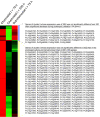Degeneration of penicillin production in ethanol-limited chemostat cultivations of Penicillium chrysogenum: A systems biology approach
- PMID: 21854586
- PMCID: PMC3224390
- DOI: 10.1186/1752-0509-5-132
Degeneration of penicillin production in ethanol-limited chemostat cultivations of Penicillium chrysogenum: A systems biology approach
Abstract
Background: In microbial production of non-catabolic products such as antibiotics a loss of production capacity upon long-term cultivation (for example chemostat), a phenomenon called strain degeneration, is often observed. In this study a systems biology approach, monitoring changes from gene to produced flux, was used to study degeneration of penicillin production in a high producing Penicillium chrysogenum strain during prolonged ethanol-limited chemostat cultivations.
Results: During these cultivations, the biomass specific penicillin production rate decreased more than 10-fold in less than 22 generations. No evidence was obtained for a decrease of the copy number of the penicillin gene cluster, nor a significant down regulation of the expression of the penicillin biosynthesis genes. However, a strong down regulation of the biosynthesis pathway of cysteine, one of the precursors of penicillin, was observed. Furthermore the protein levels of the penicillin pathway enzymes L-α-(δ-aminoadipyl)-L-α-cystenyl-D-α-valine synthetase (ACVS) and isopenicillin-N synthase (IPNS), decreased significantly. Re-cultivation of fully degenerated cells in unlimited batch culture and subsequent C-limited chemostats did only result in a slight recovery of penicillin production.
Conclusions: Our findings indicate that the observed degeneration is attributed to a significant decrease of the levels of the first two enzymes of the penicillin biosynthesis pathway, ACVS and IPNS. This decrease is not caused by genetic instability of the penicillin amplicon, neither by down regulation of the penicillin biosynthesis pathway. Furthermore no indications were obtained for degradation of these enzymes as a result of autophagy. Possible causes for the decreased enzyme levels could be a decrease of the translation efficiency of ACVS and IPNS during degeneration, or the presence of a culture variant impaired in the biosynthesis of functional proteins of these enzymes, which outcompeted the high producing part of the population.
Figures









Similar articles
-
Quantitative analysis of Penicillium chrysogenum Wis54-1255 transformants overexpressing the penicillin biosynthetic genes.Biotechnol Bioeng. 2001 Feb 20;72(4):379-88. doi: 10.1002/1097-0290(20000220)72:4<379::aid-bit1000>3.0.co;2-5. Biotechnol Bioeng. 2001. PMID: 11180058
-
Continuous cultivation of Penicillium chrysogenum. Growth on glucose and penicillin production.J Biotechnol. 1995 Sep 29;42(2):95-107. doi: 10.1016/0168-1656(95)00056-v. J Biotechnol. 1995. PMID: 7576537
-
Nonlinear biosynthetic gene cluster dose effect on penicillin production by Penicillium chrysogenum.Appl Environ Microbiol. 2010 Nov;76(21):7109-15. doi: 10.1128/AEM.01702-10. Epub 2010 Sep 17. Appl Environ Microbiol. 2010. PMID: 20851974 Free PMC article.
-
Expression of genes and processing of enzymes for the biosynthesis of penicillins and cephalosporins.Antonie Van Leeuwenhoek. 1994;65(3):227-43. doi: 10.1007/BF00871951. Antonie Van Leeuwenhoek. 1994. PMID: 7847890 Review.
-
Key role of LaeA and velvet complex proteins on expression of β-lactam and PR-toxin genes in Penicillium chrysogenum: cross-talk regulation of secondary metabolite pathways.J Ind Microbiol Biotechnol. 2017 May;44(4-5):525-535. doi: 10.1007/s10295-016-1830-y. Epub 2016 Aug 26. J Ind Microbiol Biotechnol. 2017. PMID: 27565675 Review.
Cited by
-
Anticancer activity and metabolite profiling data of Penicillium janthinellum KTMT5.Data Brief. 2019 Dec 7;28:104959. doi: 10.1016/j.dib.2019.104959. eCollection 2020 Feb. Data Brief. 2019. PMID: 31890800 Free PMC article.
-
Omics Approaches Applied to Penicillium chrysogenum and Penicillin Production: Revealing the Secrets of Improved Productivity.Genes (Basel). 2020 Jun 26;11(6):712. doi: 10.3390/genes11060712. Genes (Basel). 2020. PMID: 32604893 Free PMC article. Review.
-
Influence of oxygen concentration on the metabolism of Penicillium chrysogenum.Eng Life Sci. 2022 Apr 7;23(1):e2100139. doi: 10.1002/elsc.202100139. eCollection 2023 Jan. Eng Life Sci. 2022. PMID: 36619886 Free PMC article.
-
Functional characterization of a Penicillium chrysogenum mutanase gene induced upon co-cultivation with Bacillus subtilis.BMC Microbiol. 2014 May 6;14:114. doi: 10.1186/1471-2180-14-114. BMC Microbiol. 2014. PMID: 24884713 Free PMC article.
-
Single-Cell Technologies to Understand the Mechanisms of Cellular Adaptation in Chemostats.Front Bioeng Biotechnol. 2020 Dec 18;8:579841. doi: 10.3389/fbioe.2020.579841. eCollection 2020. Front Bioeng Biotechnol. 2020. PMID: 33392163 Free PMC article.
References
-
- Fleming A. Antibacterial Action of Cultures of A Penicillium, with Special Reference to Their Use in the Isolation of B. Influenza. Br J Exp Pathol. 1928;10:185–194.
-
- Newbert RW, Barton B, Greaves P, Harper J, Turner G. Analysis of a commercially improved Penicillium chrysogenum strain series: involvement of recombinogenic regions in amplification and deletion of the penicillin biosynthesis gene cluster. J Ind Microbiol Biotechnol. 1997;19:18–27. doi: 10.1038/sj.jim.2900411. - DOI - PubMed
Publication types
MeSH terms
Substances
LinkOut - more resources
Full Text Sources
Molecular Biology Databases

